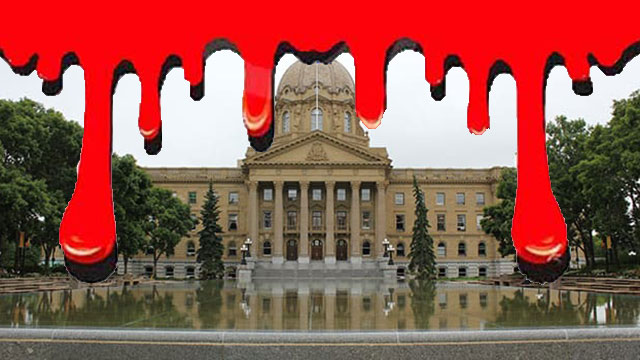Alberta must act now: Delaying fiscal reforms risks a debt spiral and economic decline

For interview requests, click here
As Albertans await the fall 2024 release of a long-term fiscal plan and the results of the newly announced Productivity Review Committee, it’s crucial to assess the province’s fiscal outlook from a sustainability perspective. The decisions made in the coming years will shape Alberta’s economic future for decades to come, and understanding the fiscal challenges ahead is vital to ensuring long-term prosperity.
Alberta’s current fiscal trajectory is unsustainable. My analysis shows that the province will need to implement permanent fiscal adjustments of around $3 billion by 2027/28 to meet its key goals. These include growing the Heritage Fund to between $250 and $400 billion by 2050, keeping annual spending increases below the combined rate of inflation and population growth, paying off $78 billion in taxpayer-supported debt, and implementing a $1.4 billion personal income tax cut.
Without these fiscal adjustments, Alberta is headed toward a future of growing deficits and escalating debt. By 2049/50, annual deficits could rise to over $13.3 billion, driven by unchecked program spending that outpaces revenue growth. In particular, spending on health care, which is already a significant portion of the budget, is expected to increase dramatically due to demographic pressures. As Alberta’s population ages, the demands on the healthcare system will intensify, with healthcare expenditures projected to account for 60 percent of operating spending by 2049/50, up from about 44 percent in 2024/25.
 |
| Recommended |
| Does Alberta really need to borrow $6.5 billion to build schools?
|
| Alberta healthcare costs threaten long-term fiscal stability
|
| 7-point action plan to grow the Alberta Heritage Fund
|
Education costs are also expected to rise substantially. With an anticipated surge in student enrollment, driven by the province’s younger population, K-12 education spending will need to increase by an average of 3.5 percent annually. The Alberta government projects that 33,000 new students will enroll each year over the next few years – four times the historical average. This enrollment growth will require about $350 million per year in additional funding to accommodate the expanding student population.
In addition to these spending pressures, Alberta faces significant challenges related to the ongoing energy transition and the push toward net-zero emissions. The province’s economy has long been heavily reliant on oil and gas revenues, but as global demand for oil peaks and Canada moves toward its 2050 net-zero targets, Alberta’s oil sector is expected to see reduced growth. My analysis indicates that, by 2050, Alberta’s oil production could drop by 54 percent, translating to a loss of 2.2 million barrels per day. This decline will have far-reaching impacts on Alberta’s economy, with cumulative provincial revenues expected to be $221 billion lower by 2050 under federal climate policies.
These fiscal and economic challenges will result in an increased debt burden for the province. By 2049/50, Alberta’s net debt could reach $144 billion, with taxpayer-supported debt rising to $303 billion, or 29 percent of GDP. Debt servicing costs will also increase, with projections showing Alberta paying $6.3 billion annually to service its debt by 2049/50, representing nearly 4.1 percent of total revenues. These figures underscore the importance of managing Alberta’s finances carefully in the face of long-term fiscal pressures.
Alberta’s population is projected to reach nearly 7.6 million by 2050, with a growing proportion of individuals aged 65 and older. This aging population will drive up healthcare costs and reduce the province’s tax base as fewer people participate in the labour force. Employment growth is expected to slow to an average of 1.5 percent annually, far below the three percent increases seen before 2014. Slower employment growth will dampen income, spending, and government revenues, further straining Alberta’s fiscal outlook.
Given these challenges, Alberta must adopt a long-term fiscal sustainability framework. Such a framework would help the government manage the risks associated with a resource-based economy, which is highly susceptible to commodity price fluctuations and demographic changes. Long-term fiscal planning should include robust analysis of the medium- to long-term impacts of government policies, demographic trends, and economic risks.
This kind of forward-looking approach will allow the government to make informed decisions today that consider their impact on future generations. For example, adopting a fiscal sustainability framework could help ensure that policies related to health care, education, and the energy transition are grounded in a clear understanding of their long-term fiscal implications.
In addition to establishing a long-term fiscal sustainability framework, the government should also regularly report on the province’s fiscal health, providing transparency and accountability to Albertans. A comprehensive fiscal sustainability report, released every three years, would give the public critical information about the province’s financial future and allow for more informed public debate.
Ultimately, addressing Alberta’s fiscal challenges will require a combination of policy reforms, fiscal discipline, and long-term planning. Without these efforts, Alberta’s fiscal position will deteriorate, leading to rising deficits, increasing debt, and a growing burden on future generations. The time to act is now – before these risks become unmanageable.
Lennie Kaplan spent over two decades in the Alberta Public Service, including as a senior manager in the Fiscal and Economic Policy Division of the Ministry of Treasury Board and Finance, where he worked on examining best practices in long-term fiscal sustainability analysis and reporting. Mr. Kaplan also served as a primary external consultant to the Office of Alberta’s Auditor General on its 2018 commentary, Putting Alberta’s Financial Future in Focus, and as Executive Director to the MacKinnon Panel on Alberta’s Finances.
Explore more on Alberta budget, Smith government, Alberta politics
The opinions expressed by our columnists and contributors are theirs alone and do not inherently or expressly reflect the views of our publication.
Troy Media
Troy Media is an editorial content provider to media outlets and its own hosted community news outlets across Canada.
